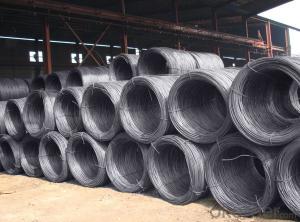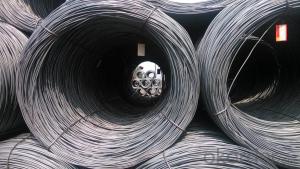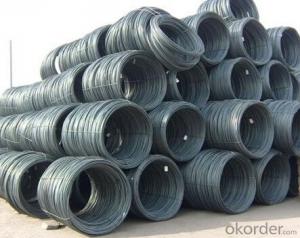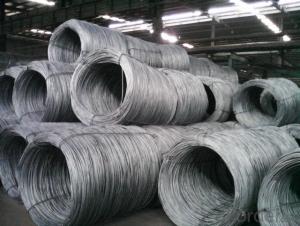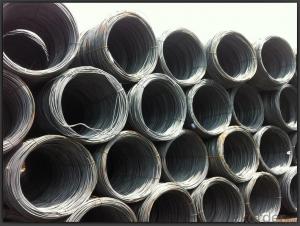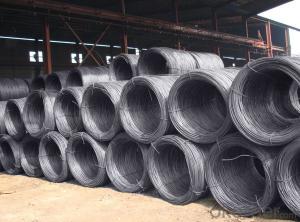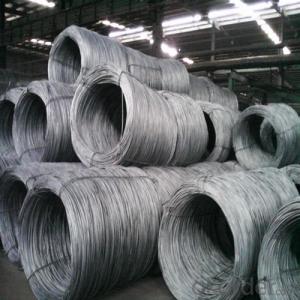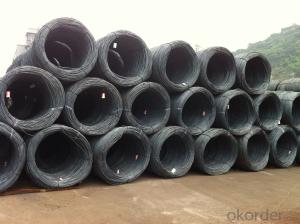Steel Wire Rod Hot Rolled SAE1008B in China
- Loading Port:
- Tianjin
- Payment Terms:
- TT or LC
- Min Order Qty:
- 27 m.t.
- Supply Capability:
- 20000 m.t./month
OKorder Service Pledge
OKorder Financial Service
You Might Also Like
Product Description:
OKorder is offering Steel Wire Rod Hot Rolled SAE1008B in China at great prices with worldwide shipping. Our supplier is a world-class manufacturer of steel, with our products utilized the world over. OKorder annually supplies products to European, North American and Asian markets. We provide quotations within 24 hours of receiving an inquiry and guarantee competitive prices.
Product Applications:
Steel Wire Rod Hot Rolled SAE1008B in China are ideal for structural applications and are widely used in the construction of buildings and bridges, and the manufacturing, petrochemical, and transportation industries.
Product Advantages:
OKorder's Steel Wire Rod Hot Rolled SAE1008B in China are durable, strong, and resist corrosion.
Main Product Features:
· Premium quality
· Prompt delivery & seaworthy packing (30 days after receiving deposit)
· Corrosion resistance
· Can be recycled and reused
· Mill test certification
· Professional Service
· Competitive pricing
Product Specifications:
1.commodity:steel wire rod
2.grade:Q195,SAE1008B-SAE1018B
3.diameter:5.5mm-14mm
4.type:in coil
5.coil weight:around 2 mt
Specification | Diameter: 5.5mm-14mm Weight of coils:50kgs or as your requirement |
Certificate | ISO9001-2008 |
Type | Low Carbon; Middle Carbon; High Carbon |
Material | Q195,Q215,Q235B,E235B,C45,C50,C55,C60,C65,C70,C75,65Mn,C72A,C72B,C80,C82B,SAE65,SAE70,SAE1006,SAE1008,SAE1010,SAE1015,SAE1018,65Mn,CT9A,GCr15, AND SO ON |
Kinds of Product | Spring Steel Wire; Cold -drawn Non-alloy Steel Wire For Springs;Carbon Steel Wires;Umbrellastand Wire; Steel Wires for Spoke; Mild Steel Wire for Important Purposes; Low Carbon Steel Wire for General Uses; Carbon Constructional Quality Steel Wires; Wire for Steel Wire Ropes Use; Galvanized Steel Wire rope; Copper Coated Steel Wire Rope etc. |
Tolerance | 1:Diameter: ±0.001 |
Tensile strength | 1400--3520 b/MPa |
Usage | Use for making Bed spring wire, Spring steel wire, Rope making wire, Tire wire, Spoke wire, High carbon steel wire, Low carbon steel wire, Cold drawn steel wire, Heat drawn steel wire, Free cutting wire, Border wire (may straightening and straight ruler) |
Packing | packing coil, plastic spool, reel bag, drum, carton and so on or according to the customer request |
trade term | FOB; CNF; CIF PORT: Xingang, Tianjin, China |
payment | T/T ,IRREVOCABLE L/C AT SIGHT |
delivery time | 1 week (1 container)after receipt of the T/T or L/C, depend on quantity |
Grade | Chemical composition table (%) | |||||
C | Mn | Si | S | P | B | |
SAE1008B | ≤0.10 | 0.3~0.50 | ≤0.15 | ≤0.050 | ≤0.040 | ≥0.0008 |
mechanical properties | ||||||
YAI (N/mm2) | Tensile Strength (N/mm2) | Elongation (%) | ||||
≥195 | 315-430 | ≥30 | ||||
FAQ:
Q1: Why buy Materials & Equipment from OKorder.com?
A1: All products offered byOKorder.com are carefully selected from China's most reliable manufacturing enterprises. Through its ISO certifications, OKorder.com adheres to the highest standards and a commitment to supply chain safety and customer satisfaction.
Q2: How do we guarantee the quality of our products?
A2: We have established an advanced quality management system which conducts strict quality tests at every step, from raw materials to the final product. At the same time, we provide extensive follow-up service assurances as required.
Q3: How soon can we receive the product after purchase?
A3: Within three days of placing an order, we will begin production. The specific shipping date is dependent upon international and government factors, but is typically 7 to 10 workdays.
Q4: What makes stainless steel stainless?
A4: Stainless steel must contain at least 10.5 % chromium. It is this element that reacts with the oxygen in the air to form a complex chrome-oxide surface layer that is invisible but strong enough to prevent further oxygen from "staining" (rusting) the surface. Higher levels of chromium and the addition of other alloying elements such as nickel and molybdenum enhance this surface layer and improve the corrosion resistance of the stainless material.
Q5: Can stainless steel rust?
A5: Stainless does not "rust" as you think of regular steel rusting with a red oxide on the surface that flakes off. If you see red rust it is probably due to some iron particles that have contaminated the surface of the stainless steel and it is these iron particles that are rusting. Look at the source of the rusting and see if you can remove it from the surface.
Images:
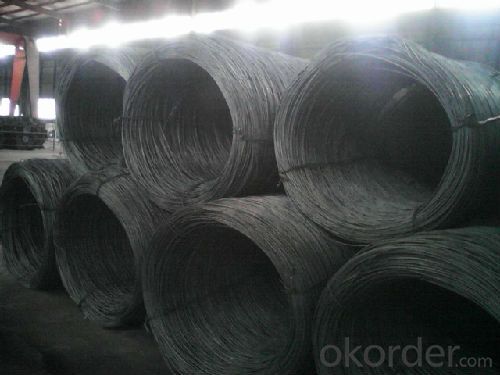
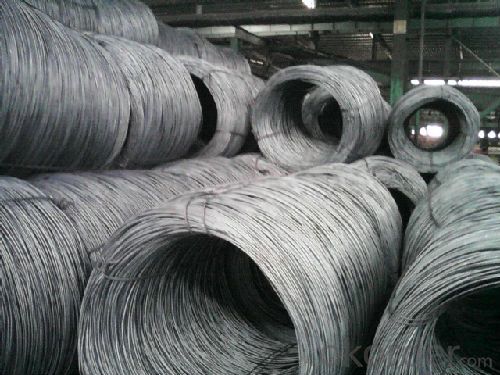

- Q: What are the common production processes for meitnerium-coated steel wire rod?
- The common production processes for meitnerium-coated steel wire rod typically involve several steps. First, the steel wire rod is cleaned and prepared to remove any impurities or contaminants. Next, a thin layer of meitnerium is deposited onto the surface of the wire rod through a process called physical vapor deposition or chemical vapor deposition. This can be done in a controlled environment using specialized equipment. After the meitnerium coating is applied, the wire rod may undergo further treatments such as annealing or heat treatment to enhance its properties. Finally, the coated wire rod is inspected, tested, and packaged for distribution or further processing.
- Q: How are steel wire rods used in the manufacturing of wire mesh for reinforcement?
- Due to their exceptional strength and durability, steel wire rods find widespread use in the production of wire mesh for reinforcement. These rods serve as the primary raw material for creating wire mesh. To begin the process, the steel wire rods are heated to high temperatures in order to soften them, facilitating easier shaping and manipulation into the desired wire mesh configuration. Subsequently, the softened rods are passed through a series of dies, gradually reducing their diameter and increasing their length. This drawing process enhances the mechanical properties of the wire rods, including tensile strength and ductility. Once the wire rods have been drawn to the desired size, they undergo further processing using specialized machines to produce the wire mesh. These machines weave or weld the individual wires together, forming a grid-like pattern commonly used for reinforcement purposes. The wire mesh is meticulously designed to provide structural support and enhance the strength of various construction materials, such as concrete. Wire mesh reinforcement is extensively employed in construction projects to prevent cracking, improve load-bearing capacity, and enhance overall structural durability. It is commonly utilized in concrete slabs, walls, columns, and foundations. The steel wire rods utilized in wire mesh manufacturing offer the necessary strength and structural integrity to withstand heavy loads and resist tension forces. In conclusion, steel wire rods play a critical role in the manufacturing of wire mesh for reinforcement. Their high strength, durability, and malleability make them an ideal material for creating wire mesh products. Through a series of processes, the wire rods are transformed into wire mesh that provides structural support and enhances the strength of various construction materials.
- Q: How is steel wire rod used in the manufacturing of wire mesh filters?
- Steel wire rod is used in the manufacturing of wire mesh filters as it serves as the raw material for creating the mesh structure. The wire rod is first drawn through a series of dies to reduce its diameter and increase its length, resulting in a thin wire. These wires are then woven or welded together to form a mesh pattern, which is essential for filtering applications. The strength and durability of steel wire rod make it ideal for withstanding the pressure and stress that wire mesh filters encounter during use.
- Q: How is steel wire rod used in the manufacturing of window and door frames?
- Window and door frames often rely on steel wire rods for their strength and durability. These rods serve as reinforcement materials, providing structural support and stability to the frames. To prepare steel wire rods for use, they undergo a series of mechanical and chemical treatments. This process includes cleaning, descaling, and coating the rods to enhance their strength and resistance to corrosion. These treatments guarantee that the rods are suitable for window and door frame applications. Once prepared, the steel wire rods are shaped and formed into the desired frame structure. This can be achieved through various techniques such as bending, welding, or using specialized machinery to mold the rods into the required shape and size. To integrate the steel wire rods into the frame structure, they are typically welded or fastened together with other components. This integration improves the overall strength and stability of the frame, ensuring it can endure the weight and pressure it will face. Furthermore, the inclusion of steel wire rods in window and door frames enhances security and resistance against break-ins. The high tensile strength of these rods makes them difficult to bend or break, providing reliable protection for residential or commercial premises. Overall, utilizing steel wire rods in the manufacturing of window and door frames brings numerous benefits, such as increased strength, durability, and security. It guarantees that the frames can endure the test of time, maintain structural integrity, and enhance the visual appeal of any building.
- Q: How is the microstructure of steel wire rod analyzed?
- The microstructure of steel wire rod is analyzed using various techniques and methods to understand its properties and quality. One common method is metallography, which involves preparing a sample of the steel wire rod by cutting and polishing it to create a flat and smooth surface. The prepared sample is then etched with a chemical solution to reveal the microstructure under a microscope. Optical microscopy is often used to analyze the microstructure of steel wire rod. It allows for the observation of various features such as grain size, grain boundaries, and the presence of any impurities or defects. This technique provides valuable information about the quality and performance of the steel wire rod. Another widely used technique is scanning electron microscopy (SEM). SEM provides a higher magnification and resolution compared to optical microscopy, allowing for more detailed analysis of the microstructure. It can reveal the surface morphology, grain boundaries, and the presence of any precipitates or phases in the steel wire rod. Transmission electron microscopy (TEM) is a more advanced technique used for analyzing the microstructure of steel wire rod. It involves preparing an extremely thin sample, typically less than 100 nanometers thick, which is then examined using an electron beam. TEM provides even higher resolution and can reveal the atomic structure, dislocations, and other fine details of the microstructure. In addition to microscopy techniques, other methods such as X-ray diffraction (XRD) and electron backscatter diffraction (EBSD) can also be used to analyze the microstructure of steel wire rod. XRD helps in identifying the crystallographic phases present in the steel wire rod, while EBSD provides information about the crystal orientations and texture. Overall, the analysis of the microstructure of steel wire rod is crucial for understanding its mechanical properties, durability, and potential applications. These various techniques and methods enable researchers and manufacturers to assess the quality and ensure the desired microstructure for specific purposes.
- Q: What are the common quality control tests performed on steel wire rod?
- To guarantee compliance with specifications and standards, various quality control tests are carried out on steel wire rod. These tests are essential to ensure the wire rod's quality and integrity before further processing or use in different applications. Common quality control tests include: 1. Analyzing Chemical Composition: This test determines the elemental composition of the steel wire rod, including carbon, manganese, phosphorus, sulfur, and other trace elements. It is crucial to meet specified limits to ensure desired mechanical properties and performance. 2. Testing Mechanical Properties: This involves evaluating tensile strength, yield strength, elongation, and other mechanical properties of the wire rod. These tests assess the rod's ability to withstand stress and deformation, ensuring suitability for the intended application. 3. Inspecting Dimensions: This test verifies the wire rod's dimensional accuracy and consistency by measuring diameter, roundness, and straightness. It ensures compliance with size and shape requirements for reliable processing or use. 4. Assessing Surface Quality: The wire rod's surface quality is visually inspected or magnified to detect defects like cracks, scales, or pitting. A smooth and defect-free surface is crucial for good adhesion, corrosion resistance, and appearance in the final product. 5. Ultrasonic Testing: This non-destructive technique detects internal defects or discontinuities in the wire rod, such as inclusions, voids, or cracks. High-frequency sound waves identify potential flaws that may compromise strength and integrity. 6. Conducting Metallurgical Analysis: This involves examining the wire rod's microstructure using microscopy techniques. It helps identify undesirable phases, grain size, and overall microstructural integrity. This analysis ensures desired metallurgical properties for optimal performance. Through these quality control tests, manufacturers ensure that steel wire rod meets standards, specifications, and customer expectations. This maintains the wire rod's quality and reliability for safe and effective use in various industries.
- Q: How is steel wire rod used in the production of wire mesh baskets for industrial applications?
- The production of wire mesh baskets for industrial applications heavily relies on steel wire rod. This rod acts as the main raw material for creating the wire mesh. To manufacture the wire mesh baskets, the steel wire rod undergoes a process called wire drawing. This process involves passing the rod through a series of dies to decrease its diameter and increase its length. As a result, a long and continuous wire is formed, which is thinner and more flexible than the original rod. The drawn wire is then woven into a mesh pattern using a machine. This weaving process creates a flexible and sturdy structure, with the size of the mesh varying based on the specific requirements of the application. Once the wire mesh is formed, it is usually cut into the desired shape and size to create the basket. The wire mesh can be easily manipulated and bent into different configurations, making it perfect for constructing baskets with specific dimensions and designs. The choice of steel wire rod in the production of wire mesh baskets is justified by its high strength and durability. Industrial applications often demand baskets capable of withstanding heavy loads or harsh environments, and steel wire provides the necessary strength and resilience. Additionally, the wire mesh structure allows for excellent visibility and airflow, making it suitable for various industrial purposes such as storage, transportation, and handling of goods. It offers secure containment while facilitating easy inspection and ventilation. In conclusion, steel wire rod plays a vital role in the production of wire mesh baskets for industrial applications. Its versatility, strength, and durability make it an ideal choice for creating baskets that can endure demanding conditions and effectively store and transport goods.
- Q: What is the difference between hot rolled and cold drawn steel wire rod?
- Various industries use hot rolled and cold drawn steel wire rods for different purposes. The manufacturing process is where the main distinction lies. Hot rolled steel wire rods undergo production by heating a billet or ingot to a high temperature. They are then rolled through a series of rollers to achieve the desired shape and dimensions. As a result, they have a larger diameter and a rougher surface finish. Construction, automotive, and machinery sectors commonly utilize hot rolled steel wire rods due to their strength and durability. Additionally, they are more cost-effective than cold drawn wire rods. In contrast, cold drawn steel wire rods are manufactured by pulling the hot rolled wire rod through a series of dies at room temperature. This process produces a smaller diameter and a smoother surface finish compared to hot rolled wire rods. Cold drawn wire rods are frequently used in applications that require precision and a smooth surface finish. Examples include the manufacturing of precision components, automotive parts, and electrical conductors. To summarize, the manufacturing process is the main factor that distinguishes hot rolled and cold drawn steel wire rods. This process affects the diameter, surface finish, and suitability for different applications. Hot rolled wire rods have a larger diameter and a rougher surface finish, while cold drawn wire rods have a smaller diameter and a smoother surface finish. The choice between the two depends on the specific requirements of the application, such as strength, precision, and surface finish.
- Q: What are the different types of steel wire rod packaging options?
- There is a wide range of packaging options available for steel wire rods, each serving the purpose of ensuring secure transportation and storage, as well as facilitating convenient handling and loading. One popular packaging option is the coil, where steel wire rods are coiled and fastened with straps or bands to keep them in place. Coils are typically placed on wooden pallets or metal frames for added stability. This option is favored due to its compatibility with forklifts or cranes, making loading and unloading a breeze. Another packaging choice is the bundle method, in which steel wire rods are grouped together and secured with bands or straps. Bundles are often positioned on wooden pallets or metal frames for stability. This option is commonly utilized for smaller quantities of wire rods or rods with larger diameters. For larger quantities or heavier wire rods, hanks are employed as a packaging solution. In this method, the rods are twisted together to form a hank, which is then secured with bands or straps. Hanks are typically placed on wooden pallets or metal frames to ensure stability. In addition to coils, bundles, and hanks, drums and spools are also utilized for packaging steel wire rods. Drums are cylindrical containers capable of holding a substantial quantity of wire rods, while spools are smaller and designed to contain a specific length or weight of wire rods. Drums and spools are commonly constructed from metal or plastic materials, offering protection to the wire rods during transportation. The selection of a packaging option depends on various factors, including the quantity and size of the wire rods, transportation requirements, and customer preferences. Each packaging option boasts its own advantages in terms of ease of handling, protection of the wire rods, and cost-effectiveness.
- Q: How is steel wire rod used in the production of springs for mattresses?
- Steel wire rod is used in the production of springs for mattresses as it serves as the raw material for creating the spring coils. The wire rod is first processed and shaped into a coiled form, which is then further processed to create the desired spring shape and size. This allows for the creation of strong and durable springs that provide support and resilience to mattresses, ensuring a comfortable sleeping surface.
Send your message to us
Steel Wire Rod Hot Rolled SAE1008B in China
- Loading Port:
- Tianjin
- Payment Terms:
- TT or LC
- Min Order Qty:
- 27 m.t.
- Supply Capability:
- 20000 m.t./month
OKorder Service Pledge
OKorder Financial Service
Similar products
Hot products
Hot Searches
Related keywords
